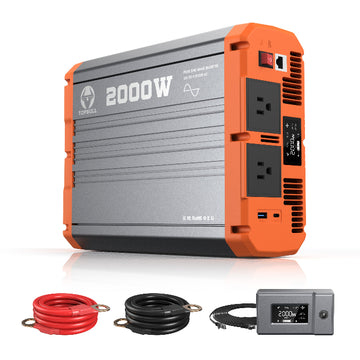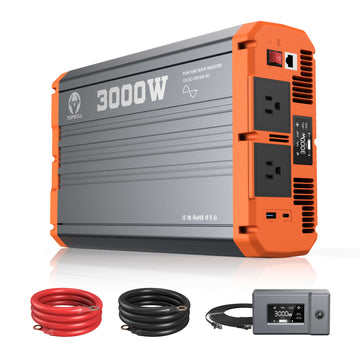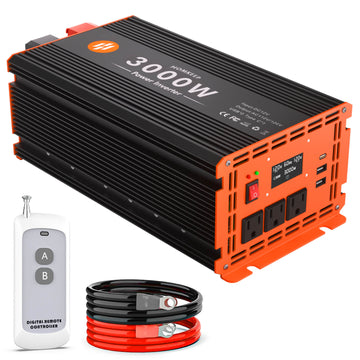With the ever-changing energy needs of America's homes and outdoor lifestyles, choosing between 1000W and 2000W power inverters has become a common dilemma. While both options play a key role in converting DC to AC power, the differences between them go far beyond wattage.
Understanding the key differences
The power label is the most intuitive difference when comparing 1000W and 2000W inverters.
Power capacity & Device compatibility
1000 Watt inverters typically support basic devices such as smartphones, LED lighting, and small kitchen appliances such as blenders or coffee makers. However, its limitations become apparent when powering multiple devices simultaneously. For example, running a 700-watt microwave oven while charging a laptop (90 watts) may push the system's load capacity up to 85%, and efficiency may drop during extended use.
In contrast, the 2000W inverter can power high-demand devices simultaneously:
- Home standby: Safely run refrigerators (600- 800W), medical CPAP machines (250W), and Wi-Fi routers (20W) with a 35% margin.
- RV camping: Handle air conditioners (1,200- 1,500W startup surges) and induction cooktops (1,800W) without tripping.
- Workplace: Power heavy-duty tools such as air compressors (1,400W continuous) while maintaining a stable voltage output.
| Equipment scenario | 1000W inverter | 2000W inverter |
| Home emergency power supply | Cell phone charging + LED light + laptop | Refrigerator (500W) + Microwave oven (1000W) +router |
| RV camping | Coffee maker (800W) + electric fan (50W) | Air conditioner (1500W) + Induction cooker (1200W) + TV |
| Outdoor work | Electric drill (600W) + LED work light (30W) | Air compressor (1400W) + Angle grinder (1100W) |
cost comparison
The cost difference between the two systems is not only in the initial purchase price of the inverter but also in several dimensions, such as battery configuration, operating efficiency, and long-term ownership costs.
The 2000W inverter is more expensive to purchase than the 1000W, which is an affordable choice for solar power systems and 12-volt automotive batteries. Moreover, 2000W inverters require twice the battery capacity of 1000W.
However, from an operational efficiency perspective, the 2000W inverter is more efficient at 50% load (~90%) than the 1000W at full load (~82%). The difference in the long-term cost of use is greater.
The choice needs to be weighed against budget and usage scenarios. 1000W is suitable for scenarios with fixed loads and no need for expansion (e.g., basic lighting or small equipment), while 2000W is more economical in terms of coping with peak power, supporting future expansion, and lowering the overall energy consumption, especially for home emergencies, RV camping, or high-power tool usage scenarios. Whether you purchase a 1000W or 2000W inverter, they both offer the same key safety features.
Difference in application scenarios between 1000W and 2000W inverters
1. Home emergency power scenario
1000W Inverter:
Used for short-term power outages (<4 hours), can support basic equipment such as LED lighting (10-20W/lamp), cell phone/laptop charging (total load <200W), Wi-Fi router (10-20W).
Cannot drive refrigerators (600-800W running power + 1500-2200W surge) or medical equipment (e.g., oxygen concentrator 300W + CPAP ventilator 250W); overload protection is triggered when the load combination exceeds 800W.
2000W inverter:
Realize multiple devices in parallel: refrigerator (600W) + microwave oven (800W) + medical equipment (300W) + basic power (100W), with a total load of 1800W, still retaining 200W redundancy.

2. RV camping & Outdoor living
1000W Inverter
It can realize the user's lightweight needs, such as a single device such as a coffee maker (800W), electric blanket (60W), or projector (200W) for time-sharing. Note that using the microwave oven (1000W) + car refrigerator (40W) at the same time will cause system overload.
2000W Inverter
Run more devices, air conditioner (1500W) + induction cooker (1200W, time-sharing) + entertainment system (200W), keeping 500W redundancy for unexpected demand.
Solar Expansion: Directly parallel 2 pieces of 400W solar panels (no additional controller needed) to realize daytime off-grid power supply.

3. Scalability scenarios
1000W Inverter
Expansion costs are high for 1000W inverters. Upgrading the system to 2000W requires replacement of cables, fuse fuses and labor costs.
2000W inverter
Total cost over 10 years: Despite a 60% higher initial investment, the long-term cost is inversely 22% lower due to extended battery life, energy efficiency benefits, and low failure rates.

Battery requirements for 1000W and 2000W inverters
The battery configuration requirements for an inverter depend on the specific equipment being operated.
For a 1000W inverter, if running on a 12V system for 4 hours with a load of 800W (safe load at 80% of rated power), lead acid batteries need to have a capacity of about 610Ah, equivalent to six 12V 100Ah batteries at a cost of about $1,100, and the actual endurance is affected by line loss and aging to be about 3.8 hours.
The depth of discharge of the battery also needs to be considered. Lithium batteries support 80% depth of discharge, requiring only two 12V 200Ah batteries, costing about $2,000, and the range can be extended to 4.5 hours. If upgrading to a 24V system with a 650W load for 2 hours, the Li-ion battery configuration can be simplified to one 24V 100Ah battery at a cost of about $1200, suitable for outdoor tooling operations.
The 2000W inverter gives you twice the capacity of the 1000W inverter. For a 24V system running for 4 hours with a 1600W load, lead-acid batteries would require a 24V array of 12 12V 100Ah batteries at a cost of about $2400, but the actual range is only 3.2 hours, and the weight is large. Lithium batteries require four 24V 100Ah batteries, costing about $4,800, with a range of up to 4.8 hours, and are lightweight and have a long life.
For off-grid scenarios such as RV camping, if a 48V system is used to drive a 1200W load for 8 hours, three 48V 100Ah Li-ion batteries are needed (about $6,000), which can satisfy all-weather power needs.
Battery type selection directly affects long-term costs.
Lead-acid batteries have a low initial cost, but with a cycle life of only 300-500 cycles and high weight, they are suitable for short-term or stationary scenarios. Li-ion batteries have a high unit cost ($0.30-0.50/Wh), but they support 80% deep discharge and more than 2,000 cycles, so the total cost of ownership is much lower, and they are especially suitable for mobile or long-term off-grid needs.
Environmental factors also need to be taken into account - lead-acid batteries degrade by 30% at low temperatures, while Li-ion batteries are stable between -20°C and 60°C, with capacity fluctuations of less than 15%.
Learn More: Lithium vs. Lead Acid Batteries: Which Is Better?
In summary, a 1000W inverter is suitable for short-term, low-load scenarios, and the battery configuration is flexible and cost-controllable; a 2000W inverter requires higher voltage and capacity support and long-term use of a Li-ion battery program. Although the initial investment is high, the high performance and long life make it more economical. Users need to weigh the short-term budget and long-term benefits based on the actual load, frequency of use, and environmental conditions to choose the optimal energy solution.

Critical inverter sizing factors that are often overlooked
Many users tend to focus only on nominal power and price when shopping for an inverter while underestimating the hidden needs of actual use. The following three commonly overlooked factors may directly affect system reliability, long-term costs, and even equipment safety:
Surge power
The inverter's surge (start-up) power carrying capacity is often misunderstood as an instantaneous value, but is closely related to the duration. For example, a 1000W inverter with a nominal 2000W surge may only be able to maintain 2000W output for 0.5 seconds, whereas compressor-type equipment (e.g., refrigerators) require 3-5 seconds of surge support for startup.
Standby power consumption
The energy consumption of an inverter in no-load or standby mode is often underestimated. Quality inverters often use intelligent hibernation technology that automatically switches to energy saving mode when a low load is detected. For motorhome users, the difference in standby power consumption is even more significant - assuming 200 days of camping throughout the year, an inefficient inverter will consume an additional 48kWh of power, equivalent to a 10% reduction in the power generation benefit of the solar panels.
System expansion
Upgrading from 1,000W to 2,000W is far from a simple matter of replacing the inverter. Users often overlook the need to upgrade ancillary components such as cables, connectors, and even fuses. For example, in a typical 12V system, a 1000W inverter requires 83A of current (at least 4 AWG wire gauge), while a 2000W system doubles the current to 166A, necessitating the use of 2/0 AWG cables to avoid the risk of overheating, and costing $120-$180 in wire replacement costs alone. Even trickier is battery system compatibility - lead-acid battery packs can face voltage mismatches when expanded.
When choosing an inverter, you need to think beyond “enough” and find a dynamic balance between power redundancy and cost control.
High quality 2000W inverter recommended

$179.99
5% discount on first order!!!
- Peak power up to 4000W with longer coverage time (usually 2-3 seconds)
- Seven built-in protection functions
- Extremely low no-load loss, energy saving, and environmental protection
- Dual intelligent temperature control fans effectively reduce machine temperature
FAQ
Q: Does a 2000W draw more current than a 1000W inverter?
A: The 2000W inverter does require more current than the 1000W inverter when running at full load, but in partial load situations, the actual current draw depends on the efficiency and load factor of the inverter.
Q: Is A 2000W inverter enough?
A: Whether a 2000-watt inverter is enough depends on your equipment needs. If you need to drive high power tools (e.g. chainsaw, air conditioner) or run multiple devices at the same time (total power close to 2000W), you need to consider surge power and efficiency loss, which may not be enough. It is recommended to reserve 20% power redundancy (i.e., actual load ≤ 1600W)
Q: What is A 1000-watt inverter good for?
A: Power cell phones, LED lights, routhigh-powerers and other basic devices. Drive coffee maker, electric blanket, small car refrigerator











![How to Install A Power Inverter in A Truck [Best Guide]](http://www.topbullshop.com/cdn/shop/articles/How-to-Install-A-Power-Inverter-in-A-Truck.jpg?v=1743407247&width=360)

